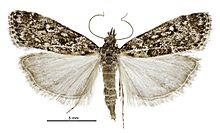Eudonia philerga facts for kids
Quick facts for kids Eudonia philerga |
|
|---|---|
 |
|
| Female | |
| Scientific classification | |
| Kingdom: | |
| Phylum: | |
| Subphylum: | |
| Class: | |
| Order: | |
| Family: | |
| Genus: |
Eudonia
|
| Species: |
E. philerga
|
| Binomial name | |
| Eudonia philerga (Meyrick, 1884)
|
|
| Synonyms | |
|
|
Eudonia philerga is a small moth that belongs to the Crambidae family. This special moth can only be found in New Zealand, meaning it is endemic there. A scientist named Edward Meyrick first described and named this moth in 1884. He shared more details about the adult moth in 1885.
Contents
What Does Eudonia philerga Look Like?
This moth is quite small. Its wingspan (the distance from one wingtip to the other) is about 17 to 21 millimeters. That's roughly the length of two small buttons side-by-side!
Forewings
The front wings, called forewings, are mostly white. They have a mix of grey and tiny black speckles. You might also see a thick, broken blackish line starting from the top edge of the wing near its body. There are two main white lines across the forewings. The first white line has a blackish edge behind it. The second white line has a dark edge in front of it.
Hindwings
The back wings, or hindwings, are a pale whitish-grey color. They sometimes have a slight yellowish-brown tint.
When Do They Fly?
Adult Eudonia philerga moths have been seen flying during certain months. These include December, January, March, and April.
What Do Eudonia philerga Moths Eat?
Like many insects, Eudonia philerga has different eating habits at different stages of its life.
Larvae Diet
When these moths are young, in their larval stage (like caterpillars), they feed on mosses. Mosses are small, soft green plants often found in damp places.
Adult Diet
Adult moths have been seen visiting the flowers of two specific plants. These are Leptospermum scoparium, also known as manuka or tea tree, and Olearia virgata. It is likely that the adult moths are feeding on nectar from these flowers.
Images for kids


